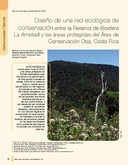| dc.contributor.author | Finegan, Bryan | |
| dc.contributor.author | Herrera Fernández, Bernal | |
| dc.contributor.author | Delgado, Diego | |
| dc.contributor.author | Campos Arce, José Joaquín | |
| dc.contributor.author | Céspedes, Margarita V. | es_ES |
| dc.contributor.author | Velásquez, Sergio | es_ES |
| dc.date.accessioned | 2015-03-19T21:17:57Z | |
| dc.date.available | 2015-03-19T21:17:57Z | |
| dc.date.issued | 2008-08 | |
| dc.identifier | 473158 | es_ES |
| dc.identifier.issn | ISSN: 1659-1216 | es_ES |
| dc.identifier.uri | https://repositorio.catie.ac.cr/handle/11554/6057 | |
| dc.description | 4 ilustraciones, 2 tabulaciones, 21 referencias, 7 páginas. | es_ES |
| dc.description.abstract | Se desarrolló y aplicó una metodología para el diseño de una red ecológica de conservación en la zona comprendida entre la Reserva de Biosfera La Amistad y la Península de Osa en Costa Rica. Mediante el método de menor costo-distancia se conectaron núcleos de hábitat priorizados a través del análisis multicriterio espacial sobre un área de 444.437 ha. Para seleccionar las redes con mayor estabilidad de conectividad estructural se identificaron criterios por medio del análisis de los cambios históricos en la estructura del paisaje y las transiciones entre usos de la tierra en un periodo de 16 años, usando imágenes Landsat TM (1987, 1997 y 2003). La red final conecta seis áreas protegidas y está compuesta por 34.479 ha de parches de bosque y 30.986 ha de un mosaico de otros siete usos de la tierra. | es_ES |
| dc.description.abstract | A methodology for the design of ecological conservation networks was developed and applied in an area located between La Amistad Biosphere Reserve and Osa Peninsula in Costa Rica. The least cost-path approach was used to connect core habitat areas selected as high priority using a spatial multi-criteria analysis, in a 444.437 ha area. Criteria for the selection of the most stable structural connectivity networks were identified by means of an analysis of historical changes in landscape structure and land use transitions, using Landsat TM images covering a 16 year period (1987, 1997 and 2003). The final network connects six protected areas, and is made up of forest fragments covering 34.479 ha, plus a mosaic of seven other land uses covering 30.986 ha. | |
| dc.language.iso | es | es_ES |
| dc.publisher | CATIE, Turrialba (Costa Rica) | es_ES |
| dc.relation.ispartof | Recursos Naturales y Ambiente Número 54 (Agosto 2008), páginas 44-50 | |
| dc.rights | info:eu-repo/semantics/openAccess | |
| dc.subject | HABITAT | es_ES |
| dc.subject | PAISAJE | |
| dc.subject | ANALISIS DE COSTOS | |
| dc.subject | UTILIZACION DE LA TIERRA | |
| dc.subject | ZONAS PROTEGIDAS | |
| dc.subject | COSTA RICA | |
| dc.subject | CONSERVACION | |
| dc.subject | CONSERVACION DE LA NATURALEZA | |
| dc.subject | RECURSOS NATURALES | |
| dc.title | Diseño de una red ecológica de conservación entre la Reserva de Biosfera La Amistad y las áreas protegidas del Área de Conservación Osa, Costa Rica | es_ES |
| dc.title.alternative | Design of an ecological conservation network between La Amistad Biosphere Reserve and the protected areas in Osa Conservation Area, Costa Rica | |
| dc.type | Artículo | es_ES |


